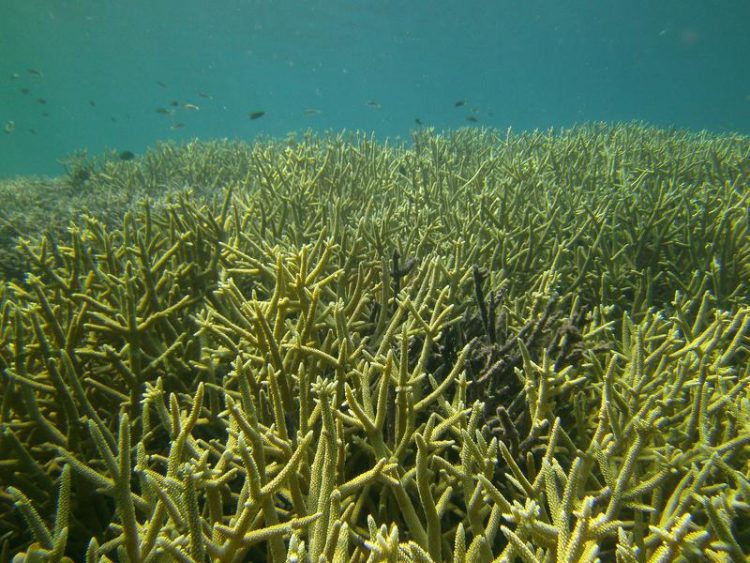Victims of their own success

Coral left: Acropora is by far the most common genus of coral with the most different species. It forms large thickets of coral, as shown here in a reef in Sulawesi, Indonesia. Photo: Wolfgang Kießling
Acropora is able to resist natural environmental influences better than other genera of coral. In fact, it even seems to use challenges such as tropical storms to its advantage in order to increase its ecological success. The delicate branches of Acropora corals are easily broken off by strong waves.
The fragments are carried away by the water and deposited elsewhere, where many of them grow and form new colonies over the course of decades and centuries. Acropora corals have been spreading in this way for around 50 million years.
However, the analyses carried out by Wolfgang Kießling and his colleagues indicate that Acropora was only a minor part of coral reefs up until the beginning of the ice age around two million years ago. It was not until after this time that the genus established itself across the globe, changing the composition of coral reefs dramatically.
The researchers believe that this was due to the massive fluctuations in sea level during this period. 'As it became warmer during interglacial periods and the ice sheets partially melted, the reefs were suddenly so deep under water that they no longer received enough light,' Professor Kießling explains. 'Only Acropora grew quickly enough towards the sun.'
Reefs with Acropora corals are more successful
Acropora's rapid growth has remained an unbeatable advantage until the present day, as the rule that determines the survival of a reef is simple: the biotope can only survive in the long-term if the corals grow more quickly than they are destroyed. And destruction happens continuously on coral reefs. Tropical storms make their mark, but even more damage is caused by other organisms such as parrotfish, sponges and fungi.
Acropora is able to keep the balance sheet in the black, creating the perfect habitat for other sea creatures. Biodiversity is higher in areas where many Acropora corals grow and they help distribute the energy of the waves, which helps protect the coast.
Acropora's success stands in stark contrast to the dark prognosis for its future. It is particularly sensitive to global warming and the associated acidification of the oceans, susceptible to diseases and coral bleaching, and the preferred target of the predatory crown-of-thorns starfish. Acropora has already receded rapidly in the Caribbean in recent decades with disastrous consequences for the coral reefs in the region. The researchers believe that it could soon face a similar future in other marine regions – not least as a result of human influence.
DOI: 10.1126/sciadv.1500850
Further information
Prof. Dr. Wolfgang Kießling
Phone: +49 9131 8526959
wolfgang.kiessling@fau.de
Media Contact
More Information:
http://www.fau.de/All latest news from the category: Life Sciences and Chemistry
Articles and reports from the Life Sciences and chemistry area deal with applied and basic research into modern biology, chemistry and human medicine.
Valuable information can be found on a range of life sciences fields including bacteriology, biochemistry, bionics, bioinformatics, biophysics, biotechnology, genetics, geobotany, human biology, marine biology, microbiology, molecular biology, cellular biology, zoology, bioinorganic chemistry, microchemistry and environmental chemistry.
Newest articles

NASA: Mystery of life’s handedness deepens
The mystery of why life uses molecules with specific orientations has deepened with a NASA-funded discovery that RNA — a key molecule thought to have potentially held the instructions for…

What are the effects of historic lithium mining on water quality?
Study reveals low levels of common contaminants but high levels of other elements in waters associated with an abandoned lithium mine. Lithium ore and mining waste from a historic lithium…

Quantum-inspired design boosts efficiency of heat-to-electricity conversion
Rice engineers take unconventional route to improving thermophotovoltaic systems. Researchers at Rice University have found a new way to improve a key element of thermophotovoltaic (TPV) systems, which convert heat…



